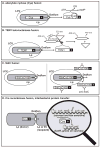Legionella pneumophila Dot/Icm translocated substrates: a sum of parts
- PMID: 19157961
- PMCID: PMC2741304
- DOI: 10.1016/j.mib.2008.12.004
Legionella pneumophila Dot/Icm translocated substrates: a sum of parts
Abstract
Legionella pneumophila is an intracellular pathogen of freshwater amoeba and of alveolar macrophages in human hosts. After phagocytosis, L. pneumophila establishes a unique intracellular vacuolar niche that avoids entry into the lysosomal network. Critical for L. pneumophila intracellular growth is the Dot/Icm type IVB translocation system. Although over 80 substrates of the Dot/Icm apparatus have been identified, individual substrates are often genetically redundant, complicating their analysis. Deletion of critical Dot/Icm translocation system components causes a variety of defects during intracellular growth. Many of these effects on the host cell likely result from the actions of one or more Dot/Icm translocated substrates. Loss of single substrates never generates the profound effects observed in strains lacking translocation system components.
Figures

Similar articles
-
Icm/dot-independent entry of Legionella pneumophila into amoeba and macrophage hosts.Infect Immun. 2004 Aug;72(8):4541-51. doi: 10.1128/IAI.72.8.4541-4551.2004. Infect Immun. 2004. PMID: 15271914 Free PMC article.
-
Legionella pneumophila strain 130b possesses a unique combination of type IV secretion systems and novel Dot/Icm secretion system effector proteins.J Bacteriol. 2010 Nov;192(22):6001-16. doi: 10.1128/JB.00778-10. Epub 2010 Sep 10. J Bacteriol. 2010. PMID: 20833813 Free PMC article.
-
Multiple substrates of the Legionella pneumophila Dot/Icm system identified by interbacterial protein transfer.Proc Natl Acad Sci U S A. 2004 Jan 20;101(3):841-6. doi: 10.1073/pnas.0304916101. Epub 2004 Jan 8. Proc Natl Acad Sci U S A. 2004. PMID: 14715899 Free PMC article.
-
Cell biology of Legionella pneumophila.Curr Opin Microbiol. 1999 Feb;2(1):30-4. doi: 10.1016/s1369-5274(99)80005-8. Curr Opin Microbiol. 1999. PMID: 10047559 Review.
-
Cellular microbiology and molecular ecology of Legionella-amoeba interaction.Virulence. 2013 May 15;4(4):307-14. doi: 10.4161/viru.24290. Epub 2013 Mar 27. Virulence. 2013. PMID: 23535283 Free PMC article. Review.
Cited by
-
Protein kinase LegK2 is a type IV secretion system effector involved in endoplasmic reticulum recruitment and intracellular replication of Legionella pneumophila.Infect Immun. 2011 May;79(5):1936-50. doi: 10.1128/IAI.00805-10. Epub 2011 Feb 14. Infect Immun. 2011. PMID: 21321072 Free PMC article.
-
Mi Casa es Su Casa: how an intracellular symbiont manipulates host biology.Environ Microbiol. 2017 Oct 27:10.1111/1462-2920.13964. doi: 10.1111/1462-2920.13964. Online ahead of print. Environ Microbiol. 2017. PMID: 29076641 Free PMC article.
-
The Legionella pneumophila effector DrrA is sufficient to stimulate SNARE-dependent membrane fusion.Cell Host Microbe. 2012 Jan 19;11(1):46-57. doi: 10.1016/j.chom.2011.11.009. Cell Host Microbe. 2012. PMID: 22264512 Free PMC article.
-
Elongation factor 1A is the target of growth inhibition in yeast caused by Legionella pneumophila glucosyltransferase Lgt1.J Biol Chem. 2012 Jul 27;287(31):26029-37. doi: 10.1074/jbc.M112.372672. Epub 2012 Jun 8. J Biol Chem. 2012. PMID: 22685293 Free PMC article.
-
Effector glycosyltransferases in legionella.Front Microbiol. 2011 Apr 12;2:76. doi: 10.3389/fmicb.2011.00076. eCollection 2011. Front Microbiol. 2011. PMID: 21833323 Free PMC article.
References
-
- Vogel JP, Andrews HL, Wong SK, Isberg RR. Conjugative transfer by the virulence system of Legionella pneumophila. Science. 1998;279:873–876. - PubMed
-
- Vincent CD, Friedman JR, Jeong KC, Buford EC, Miller JL, Vogel JP. Identification of the core transmembrane complex of the Legionella Dot/Icm type IV secretion system. Mol Microbiol. 2006;62:1278–1291. This paper uses a robust set of biochemical and genetic data to show that five proteins form the core complex of the Dot/Icm type IV translocation machinery. - PubMed
Publication types
MeSH terms
Substances
Grants and funding
LinkOut - more resources
Full Text Sources
Molecular Biology Databases

